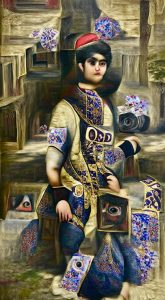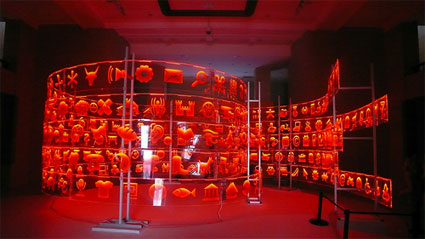 Vortex, by Christoph Hildebrand
Vortex, by Christoph Hildebrand
More notes about Synthetic Times – Media Art China, an ambitious exhibition about media art running for a few more days at the National Art Museum of China in Beijing. I can’t help but mention an interesting conversation which has just started on the spectre mailing list about whether exhibiting (and blogging about?) media art works in countries ruled by a “problematic” regime is suitable or not.
One of the last two themes, Here, There and Everywhere almost consoled me for all the misery i had to face (no access to either of my own blogs) while in Beijing courtesy of the Great Firewall of China. The works selected in this chapter envision the corollaries of the networked society: the realm where the public and the private sphere merge, the issues of control and anti-control, and the challenges of the Big Brother world.
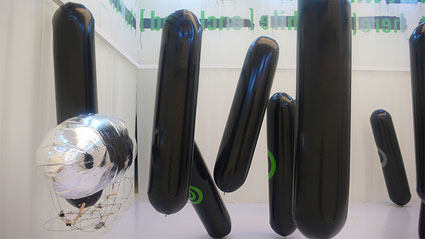 naked bandit / here, not here / white sovereign, by Knowbotic Research, is a critique of the new power structure that global information technologies are bringing about in our world. They are producing new territorial principles of order and new logics of space, as well as constituting forms of transnational power and sovereignty.
naked bandit / here, not here / white sovereign, by Knowbotic Research, is a critique of the new power structure that global information technologies are bringing about in our world. They are producing new territorial principles of order and new logics of space, as well as constituting forms of transnational power and sovereignty.
An autonomous helium-filled blimp controls and attacks black balloons, the naked bandits, which are kept captive, floating in space. The silver zeppelin, fitted with an orientation camera, is scanning the room, looking for whichever balloon is furthest away.
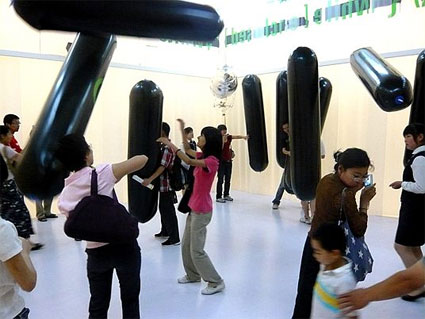 Image knowbotic research
Image knowbotic research
The harmless and tech-less black balloons are the targets of the sovereign robotic logics which role is to scan, filter, profile, detect and target. Visitors can symbolically intervene in the process. by constructing obstacles in space via their physical presence (serving as additional targets) and making the sovereign space more and more un-navigable.
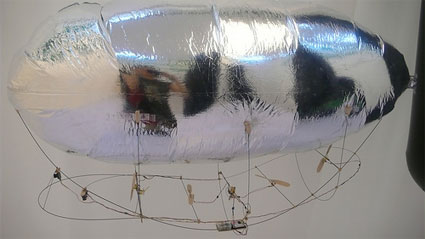
Meanwhile, coming from above, a mechanical voice repeatedly utters the words “naked bandit / here, not here” in a tone of command that is followed by a another voice representing the “naked bandit”. The sound of the installation specifies the vague status of the prisoner stripped of all rights, who is languishing incarcerated – “here” – in a very real sense. But whose legal existence is suspended – “not here”.
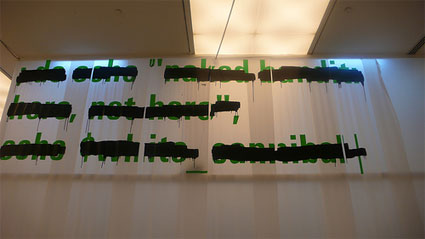
The last chapter The Recombinant Reality presents artworks which embrace the way reality is processed and meditated, revealing new types of reality that reshape our notion of existence while posing questions of epistemological urgency that characterize contemporary experience, in which a Cartesian world view no longer ensures comfort, and syllogistic reasoning finds no suitable dwelling.
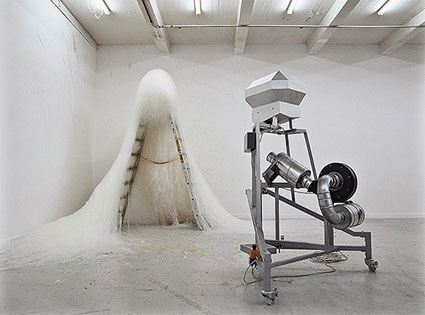
Most of Henrik Menné‘s dynamic sculptures are machines or installations are almost organic in the way they transform a material – plastic, wax, metal or stone – into objects.
56L, first created in 2004, consists of solid glue, a fan, iron, a heating element, and an engine.
56L produces a white web of glue. The machine heats up solid glue, which then flows down in thin threads in front of a fan that blows the strings in different directions and forms a surprisingly beautiful sculpture. Although the 56L machine remains the same no matter the gallery where it is displayed, the process of leading to the final glue sculpture is not only subject to change in the environment but is also relying on forces such as gravity and the peculiar qualities of the material chosen. Therefore, the exact dimensions and shape of the final work are almost impossible to control.
The work was probably the most low-tech (what is the correct expression? is it the lowest tech?) one in the show. It reminded me of Michel Blazy’s installations. The artist sets the parameters and the rest has to be left in the hands of a combination of elements.
On view until July 3, 2008 at the NAMOC in Beijing.



